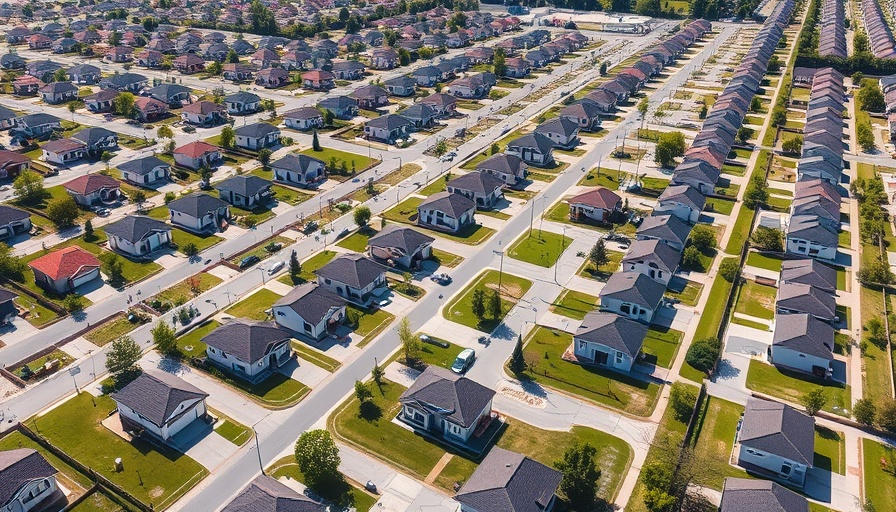
The Shift in Homeownership Trends Among Millennials
Millennials, often characterized as the generation that would rather experience life than collect possessions, are making waves in the housing market. As they transition into significant economic players, this group, defined by those aged 25-43, has emerged as the largest portion of home buyers in the U.S., accounting for 38% of purchases as of 2024. Their influence is prompting the housing industry to rethink traditional home-building practices.
Redefining the American Dream: Quality Over Quantity
While owning a home remains a cornerstone of the American Dream, millennials are prioritizing quality over sheer size. According to the National Association of Home Builders (NAHB), more than half of millennial home buyers would prefer a smaller home outfitted with luxurious amenities rather than a larger home with fewer features. This echoes a broader societal shift toward valuing experiences and community over material possessions.
Trend Towards Smaller Homes with Desirable Features
As millennials seek homes that fit their lifestyle, builders are responding by constructing smaller, more efficiently designed houses. Data from the U.S. Census Bureau reflects this trend, showing a decline in median home size from 2,300 square feet in 2019-2022 to 2,150 square feet in 2023-2024. Builders are now focusing on high-quality materials and thoughtful design—two characteristics millennials are particularly interested in.
Balancing Home Size and Location
While there's a significant preference for smaller homes, millennials still desire a comfortable amount of space, as evidenced by their request for an average of 2,408 square feet. However, many are willing to trade off square footage for proximity to urban centers, work, and amenities. This combination of desires suggests a new strategy for builders: creating vibrant communities that prioritize convenience and lifestyle.
The Modern Buyer’s Wishlist: Must-Have Features
As builders adapt to the changing demand, certain features have become particularly appealing to millennials. High-tech smart home features, eco-friendly materials, and open floor plans that promote social interaction are at the top of many wish lists. Energy efficiency is also crucial as younger generations become more environmentally conscious. These preferences not only enhance comfort but can also significantly increase a home's resale value.
Future Predictions: The Sway of Millennial Preferences
Looking forward, the real estate market will continue to adapt to the preferences of millennials. Predictions suggest that homes will become not only smaller but also more sustainable, technology-driven, and oriented towards community living. The rise of the remote work phenomenon could further fuel a demand for homes that balance a tranquil living space with a productive work environment. As construction practices evolve, the concept of homeownership itself may undergo a broader geometric shift—one that places lifestyle at the forefront.
Community and Lifestyle over Size
These changes reflect a shift in values for today's homebuyers. Millennials are gravitating toward neighborhoods that foster social connection and community engagement rather than just residential isolation. This trend is particularly visible in California, where urban and suburban areas are redefining their offerings based on these preferences. Local governments and developers might need to collaborate in creating public spaces that encourage interaction among residents, thus enriching community life.
Understanding Diverse Perspectives on Homeownership
While the trend toward downsizing and optimizing smaller living spaces may seem peculiar to previous generations, broader economic factors such as college debt, high living costs, and changing job markets have fundamentally altered millennials' approach to homeownership. Therefore, it is essential to consider the diverse backgrounds and needs of various home buyers when addressing market trends.
The Role of Innovation and Technology in Home Trends
As technology continues to advance, its integration in housing design has become indispensable. Smart home technologies not only provide convenience but also enhance energy efficiency by reducing resource consumption. This innovation reflects the priorities of millennials and Gen Z, who identify sustainability as a central value. With ongoing shifts in consumer behavior and technological advancements, the outlook for the housing industry remains optimistic, particularly for builders willing to embrace this new standard.
As the housing market evolves, potential homeowners in California and beyond should stay engaged with these trends to make informed decisions. Navigating the intricate balance of size, sustainability, and social connection will ultimately define the future of homeownership.
 Add Row
Add Row  Add
Add 




Write A Comment